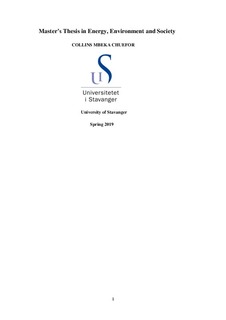| dc.contributor.advisor | Staupe-Delgado, Reidar | |
| dc.contributor.author | Chuefor, Collins Mbeka | |
| dc.date.accessioned | 2019-10-13T17:27:12Z | |
| dc.date.available | 2019-10-13T17:27:12Z | |
| dc.date.issued | 2019-07 | |
| dc.identifier.uri | http://hdl.handle.net/11250/2621786 | |
| dc.description | Master's thesis in Energy, environment and safety | nb_NO |
| dc.description.abstract | Norway’s petroleum history is comparatively short, notwithstanding it has suddenly stamped its authority as a petroleum nation using its energy geopolitical influence to make its voice heard in Europe and beyond. Few accidents in the early stage of its journey to becoming an oil-dependent nation forced important legislative instruments to regulate the oil industry. The rising cost of operation in the North Sea due to aging oil fields and the discovery of large deposits in the High North accelerated the award of licenses to for operation in the Barents and the Lofoten areas ( including the Norwegian Sea) a move considered by environmentalist as unconstitutional and a step away from the commitments made under the Paris Agreement to reduce CO2.
While Taleb’s Black Swan Theory serves as a useful tool to policy makers and managers of the danger of hindsight bias in decision making, Perrow’s Normal Accident Theory and Todd Laporte’s High Reliability Theory constitute useful analytical frameworks to understand the possibility and impossibility of safety. However, findings through interviews from experts on the narratives of safety, vulnerability and preparedness in the High North after analyses reveal four conceptual frameworks namely:
- Too risky to drill in the Arctic
- Risk acknowledgement in Arctic drilling but necessary hence, good preparedness plans in place.
- Sceptic outlook on safe Arctic drilling
- Optimistic outlook on safe drilling in the Arctic
These conceptual frameworks lead to the understanding that the polarised atmosphere is Norway’s Arctic oil and gas exploitation is a product of mistrust and normative interpretations based on vested interest amongst stakeholders. The degree of Norway’s readiness to drill in the Arctic is shaped by the conception of the stakeholders’ ‘truth’ and the provenance of their ‘truths’ hinges on their overall objectives leaving one with a paradox of safety and Arctic oil money.
The quest for Arctic oil has stirred debates on the possibility and impossibility of drilling in the Arctic. The debate is characterised by differentials in the interpretation of risks and how prepared Norway is to expand its oil and gas exploitation further north. While the possibility argument has been pecked on the economic importance of oil and gas to sustain the economy and maintain the Norwegian generous welfare system, this research reveals among other things that the question of possibility and readiness are conflated with the importance of Arctic oil to Norway leading to juxtapositions in policy priorities. On the other hand, the impossibility debate has been dominated by vulnerability and safety concerns due to the specificity of the Arctic such as ice and icy conditions, remoteness, darkness, wind and high waves. This argument is spurred by environmentalism and reinforced by scientific evidence and literature on the Arctic. Furthermore, the Norway Auditor General’s recent report has added new impetus into the impossibility narrative as it concluded amongst other things that the equipment and technology in the High North are not adaptable for the Arctic. The objective of this study is not to come to any conclusion on the narrative but rather to understand how they are presented and their motivating factors in order to suggest avenues for further research as well as contribute to shaping policy by clarifying and unpacking the arguments. | nb_NO |
| dc.language.iso | eng | nb_NO |
| dc.publisher | University of Stavanger, Norway | nb_NO |
| dc.relation.ispartofseries | Masteroppgave/UIS-SV-IMS/2019; | |
| dc.subject | High North | nb_NO |
| dc.subject | Arctic | nb_NO |
| dc.subject | oil and gas | nb_NO |
| dc.subject | olje og gass | nb_NO |
| dc.subject | environmentalists | nb_NO |
| dc.subject | emergency preparedness | nb_NO |
| dc.subject | oil spill | nb_NO |
| dc.subject | drilling | nb_NO |
| dc.subject | vulnerability | nb_NO |
| dc.subject | boring | nb_NO |
| dc.subject | Arktis | nb_NO |
| dc.subject | energi, miljø og samfunn | nb_NO |
| dc.title | Safety and Vulnerability in Arctic Oil and Gas Exploitation in Norway: How do various stakeholders interpret risks and readiness? | nb_NO |
| dc.type | Master thesis | nb_NO |
| dc.subject.nsi | VDP::Social science: 200 | nb_NO |
| dc.subject.nsi | VDP::Technology: 500::Environmental engineering: 610 | nb_NO |
